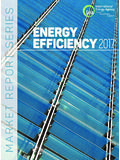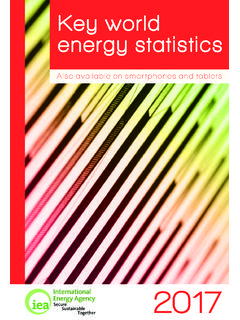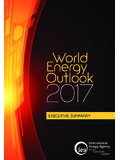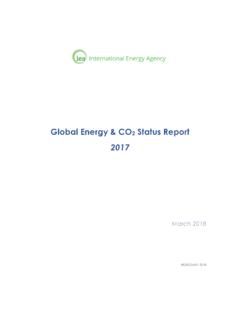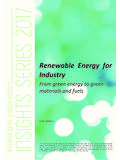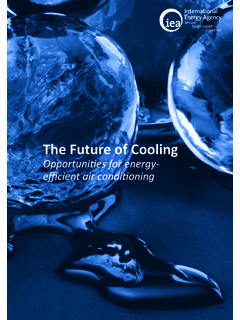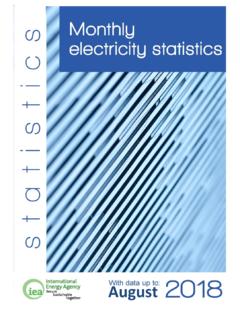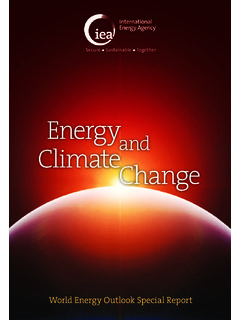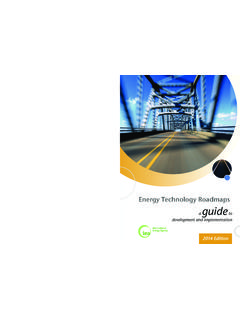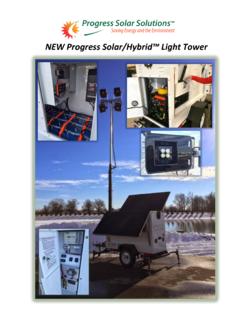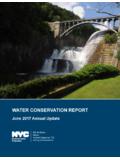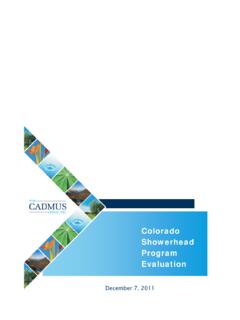Transcription of Tracking Clean Energy Progress 2017
1 Tracking Clean Energy Progress 2017 Energy Technology Perspectives 2017 ExcerptInforming Energy Sector TransformationsDesign by MSDS | Photo credit: Photdisc | Shutterstock our website forinteractive tools, additional data, presentations and systems are undergoing substantial changes. Tracking the Progress of Clean Energy is essential to achieve sustainable, secure and affordable Energy and to assess collective Progress towards long-term IEA s annual Tracking Clean Energy Progress (TCEP) report highlights the overall status and recent Progress in developing and deploying key Clean - Energy technologies. The report brings together broad IEA expertise, integrating the analysis from the Energy Technology Perspectives as well as the Market Report year, TCEP assesses the latest Progress in technology and market developments, tracks overall Progress , and recommends further actions.
2 TCEP this year shows that only 3 of 26 identified Clean Energy technologies are on track to meet a sustainable Energy transition (one more than last year). 15technologies showed only some Progress , and 8 are significantly off-track and in need ofrenewed action. TC E P 2017 also includes a special section on Tracking Clean Energy innovation, containing unique information on public and private investment in research, development, and demonstration. The special section highlights that total innovation investment needs to pick up to fulfill its important role of achieving secure and sustainable Energy systems and delivering economic growth and reducing air Clean Energy Progress 2017 Energy Technology Perspectives 2017 Excerpt Informing Energy Sector TransformationsTracking Clean Energy Progress 111-05- 2017 15:03:55 Tracking Clean Energy Progress 2017 Release 6 June 2017 Energy Technology Perspectives 2017 Excerpt Informing Energy Sector TransformationsINTERNATIONAL Energy AGENCYThe International Energy Agency (IEA), an autonomous agency, was established in November 1974.
3 Its primary mandate was and is two-fold: to promote Energy security amongst its member countries through collective response to physical disruptions in oil supply, and provide authoritative research and analysis on ways to ensure reliable, affordable and Clean Energy for its 29 member countries and beyond. The IEA carries out a comprehensive programme of Energy co-operation among its member countries, each of which is obliged to hold oil stocks equivalent to 90 days of its net imports. The Agency s aims include the following objectives: nSecure member countries access to reliable and ample supplies of all forms of Energy ; in particular,through maintaining effective emergency response capabilities in case of oil supply sustainable Energy policies that spur economic growth and environmental protectionin a global context particularly in terms of reducing greenhouse-gas emissions that contributeto climate transparency of international markets through collection and analysis ofenergy global collaboration on Energy technology to secure future Energy supplies and mitigate their environmental impact.
4 Including through improved energyefficiency and development and deployment of low-carbon solutions to global Energy challenges through engagement anddialogue with non-member countries, industry, internationalorganisations and other member countries: Australia Austria Belgium CanadaCzech RepublicDenmarkEstoniaFinlandFranceGerma nyGreeceHungaryIreland ItalyJapanKoreaLuxembourgNetherlandsNew Zealand NorwayPolandPortugalSlovak RepublicSpainSwedenSwitzerlandTurkeyUnit ed KingdomUnited StatesThe European Commission also participates in the work of the note that this publication is subject to specific restrictions that limit its use and distribution. The terms and conditions are available online at OECD/IEA, 2017 International Energy Agency Website: of contents 3 OECD/IEA, 2017 .
5 Table of contents Introduction 4 45917 Foreword Key messages Summary of Progress Tracking Progress : How and against what? Tracking Clean Energy Progress and the Paris goals 20 Tracking Clean Energy Progress 23 Renewable power 24 Nuclear power 28 Natural gas-fired power 30 Coal -fired power 32 Carbon capture and storage 34 Industry 36 Chemicals and petrochemicals 40 Pulp and paper 42 Transport 44 Electric vehicles 46 International shipping 48 Fuel economy of LDVs 50 Transport biofuels 52 Buildings 54 Building envelopes 56 Lighting, appliances and equipment 58 Renewable heat 60 Energy storage 62 Tracking Clean Energy innovation Progress 65 Track ing Clean Energy innovation Progress 66 Key messages 66 Introduction 67 Tracking RD&D spending 69 Recommendations 85 Annexes 93 Acronyms.
6 Abbreviations, units of measure and regional groupings 94 Technology overview notes 99 References 107 Acknowledgements 1114 Introductio n Foreword OECD/IEA, 2017 . Foreword Energy systems around the world are undergoing substantial changes. Many of these shifts are being driven by purposeful government policies, whether to put a country on a low -carbon transition path, reduce air pollution, s ecu re Energy independence and s ecurity, or re duce costs and i mprove efficiencies. Other changes are being driven by ext ernal forces, including broader movements in Energy markets or by deep societal transformations such as the increased u se o f i nformation and communications technologies in every wake of life.
7 In order to navigate this ever- changing Energy landscape, governments, companies, and other stakeholders need information. It is critical to know where we are before knowing where we want to go. What is the existing state of technologies across different parts of the Energy sector, where are governments steering their Energy systems, what Progress is being made and how ca n their g oals be achieved efficiently and cos t-effectively? The I EA Tracking Clean Energy Progress (TCEP) provides such a tool, and can help governments, companies, and other stakeholders build cleaner and more sustainable Energy systems. Different technologies will of course be more or less relevant in different countries, which is why TCEP takes a broad and technology-neutral approach that covers a full range of Energy subsectors from bioenergy to nuclear, from building envelopes to key industries, from solar photovoltaics to carbon capture and storage (CCS).
8 This year, the report includes a special feature on Clean Energy innovation, which brings the world s best d ata on public and private investment in re search, development, and demonstration (RD&D) in one place. This should be h elpful to all global actors, but especially for those countries involved in Mission Innovation who have p ledged to d ouble their Clean Energy innovation budgets over five years as well as for key private sector actors like the Breakthrough Energ y Coalition. These public and private efforts carry enormous p otential to help d evelop t he technologies of tomorrow. These efforts will be c ritical to help countries achieve the long-term goals of the Paris Agreement on climate change but also to reduce air pollution, bolster Energy security and invigorate the economies of tomorrow.
9 Thanks to its growing famil y of member and partner governments, wide and d eep b usiness partnerships, and unparalleled expert an alysts, which includes 6 000 global experts in its Technology Collaboration Programmes, the IEA strives to help the world a chieve its Energy policy goals and d o s o ef ficiently and effectively. Progress has been made t o ensure t hat I EA analysis is more ac cessible, and a new interactive web portal for TCEP has been created on t he IEA website. It is my hope that TCEP 2017 is useful in our shared effort to promote sustainable and secure Energy systems for the future. Dr. Fatih Birol Executive Director International Energy Agency Introduction Key messages 5 OECD/IEA, 2017 .
10 Key messages In 2016, 3 of the 26 tracked technologies were green , that is, on track toward a sustainable Energy transition: more mature variable renewables (onshore wind and solar), electric vehicles, and Energy storage. While presently representing only a small share of the total Energy system, these technologies are rapidly scaling up and cont inue to strengthen their position as mainstream Energy A new historic record has been reached in the electrification of passenger transportation, with over 750 000 electric vehicles (EVs) sold in 2016, raising the global stock to two million. A slowdown in market growth of 40% in 2016 from 70% in 2015 still maintains EVs on track to reach 2 C Scenario (2DS) levels in 2025, but put s the technology at significant risk of missing the 2020 interim milestone and in turn raises risks toward the 2025 goal.
